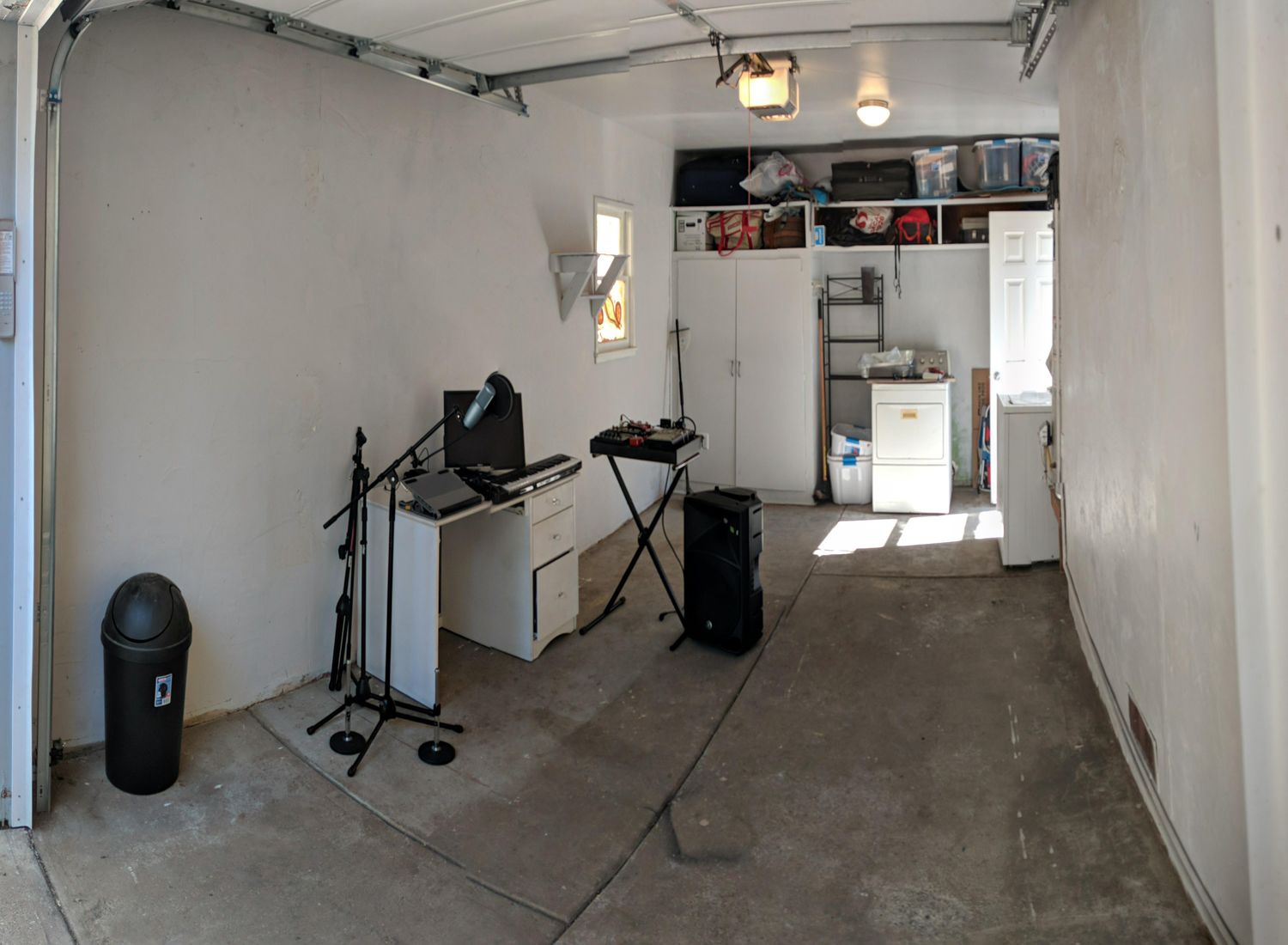Home>Production & Technology>Soundproofing>What Can I Use For Soundproofing


Soundproofing
What Can I Use For Soundproofing
Published: January 26, 2024
Looking for effective soundproofing solutions? Discover what you can use to effectively block out unwanted noise and create a quieter environment with our soundproofing tips and products.
(Many of the links in this article redirect to a specific reviewed product. Your purchase of these products through affiliate links helps to generate commission for AudioLover.com, at no extra cost. Learn more)
Table of Contents
Introduction
Welcome to the world of soundproofing! Whether you live in a bustling city apartment, work in a busy office, or simply want to create a peaceful environment in your home, soundproofing can significantly reduce unwanted noise and enhance your overall acoustic experience.
Soundproofing is the process of minimizing or eliminating the transmission of sound from one area to another. It involves using various techniques and materials to create barriers that prevent sound waves from traveling through walls, floors, ceilings, doors, and windows.
Why is soundproofing important? Excessive noise can have a detrimental effect on our health and well-being. It can disrupt sleep patterns, increase stress levels, and affect concentration and productivity. By soundproofing our living or working spaces, we can create a quieter, more peaceful environment that promotes relaxation, concentration, and overall comfort.
Now, you might be wondering: “What can I use for soundproofing?” The good news is that there are a variety of materials and methods available to help you achieve effective soundproofing. The key is to understand your specific needs and choose the right solutions accordingly.
In this comprehensive guide, we will explore different soundproofing methods for walls, floors, ceilings, windows, doors, and even HVAC systems. We’ll also delve into the materials used for soundproofing and provide insights on choosing the most suitable options for your specific requirements.
Whether you’re a homeowner looking to create a more peaceful environment, a business owner aiming to improve productivity and comfort in the workplace, or simply someone in search of a good night’s sleep, this guide will equip you with the knowledge and tools to embark on your soundproofing journey.
So, let’s dive in and discover the secrets of soundproofing that will transform your space into an oasis of tranquility and serenity!
Understanding Soundproofing
Before diving into the world of soundproofing, it’s essential to have a basic understanding of how sound works and how it travels. Sound is a form of energy that travels in waves, and it requires a medium, such as air, water, or solid objects, to travel through.
When sound waves encounter objects or surfaces, they can be absorbed, reflected, or transmitted. Absorption occurs when sound waves are absorbed by materials, converting the sound energy into heat. Reflection happens when sound waves bounce off surfaces, changing their direction. Transmission refers to the passing of sound waves through a material or object.
Soundproofing aims to disrupt the path of sound waves to reduce or eliminate their transmission into or out of a specific space. It involves creating barriers and using materials that minimize the vibrations and resonance that sound waves produce.
To effectively soundproof a room or space, it’s important to consider the various elements that can contribute to noise transmission. These elements include walls, floors, ceilings, windows, doors, and even HVAC systems.
When it comes to soundproofing, there are two primary types of sound: airborne sound and impact sound. Airborne sound refers to sound waves that travel through the air, such as voices, music, or traffic noise. Impact sound, on the other hand, is caused by physical impact or vibrations, such as footsteps or objects being dropped.
Understanding the type of sound you want to minimize or eliminate in your space will help you determine the most effective soundproofing methods and materials to use.
It’s also important to note that soundproofing is not the same as sound absorption. While soundproofing focuses on preventing sound transmission, sound absorption involves reducing the amount of reflected sound within a room. Sound absorption can be achieved with the use of acoustic panels, curtains, foam materials, and other porous materials that can absorb sound waves.
Now that we have a better understanding of the basics of soundproofing, let’s explore the different materials and methods that can be used to create a quieter and more peaceful environment in your space.
Choosing the Right Materials
When it comes to soundproofing, selecting the appropriate materials is crucial for achieving the desired level of noise reduction. The right materials can effectively block, absorb, or dampen sound waves, minimizing the transmission of noise from one area to another. Here are some key materials commonly used in soundproofing:
- Mass-Loaded Vinyl (MLV): MLV is a dense, flexible barrier material that is highly effective in blocking sound transmission. It can be used as an additional layer on walls, floors, or ceilings to create a sound-blocking barrier. MLV is often used in combination with other soundproofing materials for enhanced results.
- Acoustic Foam: Acoustic foam is a popular choice for soundproofing walls and ceilings. It is designed to absorb sound waves, reducing reflections and echo within a space. Acoustic foam is available in various thicknesses and patterns, allowing for customization based on specific needs and aesthetic preferences.
- Green Glue: Green Glue is a viscoelastic compound that is applied between layers of drywall, plywood, or other construction materials. It works by converting sound energy into heat, effectively reducing sound transmission. Green Glue is easy to use and can significantly improve the soundproofing capabilities of walls, floors, and ceilings.
- Insulation Material: High-quality insulation material, such as fiberglass or mineral wool, can significantly reduce airborne sound transmission. It can be installed within walls, floors, or ceilings to add an extra layer of soundproofing. Insulation material also offers thermal insulation benefits, improving energy efficiency.
- Soundproof Curtains: Soundproof curtains or drapes are made from dense, layered fabrics that are designed to absorb sound. They can be used to cover windows, doors, or even walls to reduce external noise and improve sound isolation within a room. Soundproof curtains are an affordable and convenient option for temporary or movable soundproofing solutions.
- Sealants: Proper sealing of gaps, cracks, and openings is essential for effective soundproofing. Acoustic sealants, such as silicone or caulk, can be used to fill in any air leaks or small openings that allow sound to pass through. This helps to create an airtight and soundproof barrier.
When choosing soundproofing materials, it’s important to consider factors such as the level of soundproofing required, the specific application area, budget, and aesthetic preferences. Consulting with an expert or conducting research on the best materials for your specific needs can help ensure optimal results.
Now that we have a better understanding of the materials used in soundproofing, let’s explore specific soundproofing methods for different areas of your space.
Soundproofing Methods for Walls
Walls are one of the primary pathways for sound transmission, so effectively soundproofing them is essential for creating a quiet and peaceful environment. Here are some soundproofing methods for walls:
- Add Mass: Increasing the mass of the walls is a simple yet effective way to improve soundproofing. This can be done by adding an extra layer of drywall, plywood, or mass-loaded vinyl (MLV). The additional mass helps to block sound waves, reducing noise transmission.
- Install Acoustic Panels: Acoustic panels are designed to absorb sound waves and reduce reflections within a space. They can be mounted on walls to improve sound quality and minimize noise transfer. Acoustic panels come in various sizes, shapes, and designs, allowing for both effective soundproofing and aesthetic enhancements.
- Use Soundproof Wallpaper: Soundproof wallpaper is specially designed with sound-absorbing materials to reduce noise transmission through walls. It can be applied directly over existing wallpaper or painted walls. Soundproof wallpaper is available in various designs and patterns, making it a functional and stylish soundproofing solution.
- Seal Air Leaks: Gaps, cracks, and openings in walls can allow sound to pass through. Ensure that all air leaks are properly sealed with acoustic sealants or caulking. This helps to create an airtight barrier and minimizes sound leakage.
- Decouple the Walls: Decoupling involves creating an air gap between layers of the wall to disrupt the transmission of sound waves. This can be achieved by using resilient channels, sound isolation clips, or rubber isolators. The air gap helps to absorb and dampen sound vibrations, reducing noise transfer through the walls.
- Soundproof Insulation: Installing soundproof insulation within the wall cavity can greatly improve soundproofing. Materials such as mineral wool or fiberglass insulation absorb sound waves and reduce noise transmission through the walls. Be sure to choose insulation with good soundproofing properties for optimal results.
It’s important to note that combining multiple soundproofing methods can yield the best results. Different walls may require different approaches depending on their construction and the level of soundproofing desired. Consulting with a professional or conducting thorough research can guide you in choosing the most suitable soundproofing methods for your walls.
Now that we’ve explored soundproofing methods for walls, let’s move on to soundproofing techniques for floors.
Soundproofing Methods for Floors
When it comes to soundproofing, floors can be a major culprit in transmitting both airborne and impact noise. Whether you’re dealing with footsteps, loud music from downstairs, or even machinery vibrations, soundproofing your floors can greatly enhance the acoustic comfort of your space. Here are some effective soundproofing methods for floors:
- Use Carpet or Rugs: Adding a thick carpet or rug to your floors can help absorb and reduce impact noise, such as footsteps or dropped objects. The soft fibers of the carpet act as a buffer, minimizing the transmission of vibrations from the floor to the rooms below.
- Install Floor Underlayment: Floor underlayment is a layer of material installed beneath the flooring to dampen sound and reduce noise transmission. There are various types of underlayment available, such as foam, cork, or rubber. Choose an underlayment specifically designed for soundproofing to enjoy maximum noise reduction.
- Float the Floor: Floating floors are an effective way to isolate and minimize sound transmission between floors. This involves installing a layer of soundproof underlayment followed by a floating floor system, which is not directly attached to the subfloor. The air gap created between the subfloor and the floating floor helps to reduce both impact and airborne noise.
- Fill Floor Cavities: If you have access to the floor cavities, filling them with insulation can significantly improve soundproofing. Material such as spray foam or cellulose insulation can effectively reduce noise transmission through the floor. It’s crucial to ensure proper installation to maximize its effectiveness.
- Seal Floor Gaps and Cracks: Just as with walls, sealing any gaps, cracks, or openings in the floor is crucial for soundproofing. Use acoustic sealants or caulking to seal these areas and prevent sound leakage.
- Install Soundproofing Mat or Mass-Loaded Vinyl: Soundproofing mats or mass-loaded vinyl (MLV) can be installed directly under the flooring material to add mass and dampen sound vibrations. This can be particularly effective for reducing impact noise, such as footsteps or heavy objects being dropped.
As with any soundproofing project, it’s important to consider the specific requirements of your space and the type of noise you’re trying to reduce. Additionally, combining multiple soundproofing methods can yield the best results. Consulting with a professional or conducting thorough research will help you determine the most suitable soundproofing methods for your floors.
Now, let’s move on to soundproofing methods for ceilings.
Soundproofing Methods for Ceilings
When it comes to sound transmission, ceilings can play a significant role, especially in multi-story buildings or spaces with shared ceilings. Soundproofing the ceiling can help reduce both airborne and impact noise, creating a quieter environment. Here are some effective soundproofing methods for ceilings:
- Add Acoustic Insulation: Installing acoustic insulation in the ceiling cavity can help reduce sound transmission. Materials such as mineral wool or fiberglass insulation are excellent at absorbing sound waves and improving soundproofing.
- Install a Drop Ceiling: A drop ceiling, also known as a suspended ceiling, can be an effective solution for soundproofing. The drop ceiling consists of a grid system with ceiling tiles that create an air gap between the existing ceiling and the new ceiling. This airspace helps absorb and dampen sound waves, reducing noise transmission.
- Apply Acoustic Panels: Installing acoustic panels on the ceiling can absorb and reduce sound reflections, improving sound quality and minimizing noise transfer between floors or rooms. These panels are available in various designs and can be a stylish addition to your space.
- Use Mass-Loaded Vinyl: Mass-loaded vinyl (MLV) can be installed on the ceiling to add mass and block sound transmission. It can be applied directly to the ceiling or sandwiched between layers of drywall. MLV is an effective soundproofing material that helps reduce airborne noise.
- Seal Ceiling Cracks: Just like with walls and floors, sealing any gaps, cracks, or openings in the ceiling is essential for soundproofing. Use acoustic sealants or caulking to seal these areas and prevent sound leakage.
- Decouple the Ceiling: Decoupling the ceiling involves creating an air gap between the ceiling and the structure above. This can be done using resilient channels or sound isolation clips. The air gap helps absorb sound vibrations and prevents direct transmission, reducing noise transfer.
Remember, the effectiveness of soundproofing methods for ceilings can depend on factors such as ceiling construction, the type of noise you want to reduce, and the accessibility of the ceiling space. Consider consulting with a professional to ensure you choose the most suitable soundproofing techniques for your specific space.
Now, we will move on to soundproofing methods for windows.
Soundproofing Methods for Windows
Windows are often a significant source of noise transmission, allowing both airborne and exterior sounds to enter your space. Fortunately, there are several effective methods for soundproofing windows to create a quieter and more peaceful environment. Here are some soundproofing methods for windows:
- Install Soundproof Curtains or Drapes: Soundproof curtains or drapes are made from dense and heavy fabrics designed to absorb sound waves. Installing these curtains over your windows can help reduce external noise and improve sound insulation within your space.
- Add Weatherstripping: Weatherstripping is typically used for energy efficiency but can also help with soundproofing. By sealing any gaps between the window frame and the sash, weatherstripping prevents external noise from entering and improves sound insulation.
- Apply Window Film: Soundproof window films are specifically designed to reduce noise transmission through windows. These films are typically made of a combination of polyester and adhesive, which helps to absorb and dampen sound vibrations.
- Install Acoustic Panels: Acoustic panels can be mounted on the walls surrounding the windows to absorb sound reflections and reduce noise transfer. By placing these panels strategically near the windows, you can lessen the impact of sound entering through the window panes.
- Upgrade to Soundproof Windows: If noise is a persistent issue, consider investing in soundproof windows. These windows are manufactured with multiple layers of glass, laminated with acoustic material, and often have thicker frames. Soundproof windows are highly effective in reducing noise transmission and creating a quieter indoor environment.
- Use Window Inserts: Window inserts consist of an additional layer of glass or acrylic that can be easily installed on the interior side of existing windows. These inserts create an extra barrier against noise and help improve sound insulation.
Remember, the effectiveness of soundproofing methods for windows may vary based on factors such as the proximity to noisy areas, the thickness and quality of the window glass, and your specific soundproofing goals. It’s important to consider your individual needs and consult with professionals for the best solutions.
Now, let’s move on to soundproofing methods for doors.
Soundproofing Methods for Doors
Doors can be a major source of noise transmission due to their hollow construction and gaps around the edges. Soundproofing your doors can significantly reduce the amount of noise that enters or exits a room. Here are some effective methods for soundproofing doors:
- Weatherstripping: Applying weatherstripping around the door frame can create a tight seal and reduce sound leakage. Choose a high-quality weatherstripping material, such as adhesive-backed foam or rubber, that can effectively block sound waves.
- Install Door Sweep: A door sweep, installed at the bottom of the door, can help seal the gap between the door and the floor. It prevents sound from traveling through the bottom of the door and reduces noise transmission.
- Use Door Gaskets or Seals: Door gaskets or seals can be installed around the edges of the door to create an airtight seal. These seals help block sound waves, preventing noise leakage through the gaps around the door.
- Add Mass to the Door: Increasing the mass of the door can effectively reduce noise transmission. You can achieve this by attaching mass-loaded vinyl (MLV) or a layer of drywall to the door’s surface. Adding mass helps absorb sound vibrations and improves soundproofing capabilities.
- Insulate the Door: Applying insulation material to the inside of the door can help absorb sound and dampen vibrations. Use soundproofing foam panels or fiberglass insulation to improve the door’s soundproofing properties.
- Install Soundproofing Blankets or Curtains: Soundproofing blankets or curtains can be hung over the door to create a barrier that absorbs sound. These blankets are made from dense materials and effectively reduce noise transmission through the door.
- Replace the Door: If your current door is particularly thin or hollow, replacing it with a solid-core door or a specially designed soundproof door can provide significant improvement in noise reduction. These doors are constructed with materials that have better soundproofing qualities.
Keep in mind that the effectiveness of soundproofing methods for doors may vary depending on factors such as door material, construction, and the amount of noise you’re trying to block. Consider your specific needs and consult with professionals to select the most suitable soundproofing techniques for your doors.
Now, let’s explore soundproofing methods for HVAC systems.
Soundproofing Methods for HVAC Systems
HVAC (Heating, Ventilation, and Air Conditioning) systems can generate noise due to the movement of air, vibrations from equipment, or the operation of fans and compressors. This noise can be disruptive and affect the overall comfort of your space. Here are some effective methods to soundproof HVAC systems:
- Absorb Vibrations: Vibrations from HVAC equipment can contribute to noise transmission. Using anti-vibration pads or mounts beneath the equipment can help absorb vibrations, reducing noise levels.
- Install Soundproofing Blankets or Panels: Soundproofing blankets or panels can be placed around HVAC equipment to absorb sound waves and minimize noise. These specially designed materials are dense and effectively reduce noise transmission from the equipment.
- Enclose the Equipment: Building an enclosure or a soundproof box around the HVAC equipment can help contain and minimize noise. The enclosure should be constructed with soundproofing materials and designed to allow sufficient airflow for the equipment to function properly.
- Use Soundproof Duct Insulation: Installing soundproof duct insulation can help dampen the noise generated by air movement within the HVAC ducts. Insulating the ducts with materials such as fiberglass or foam can significantly reduce noise transmission through the system.
- Seal Air Leaks: Ensure that all joints, seams, and connections in the HVAC ductwork are properly sealed to prevent air leaks. Air leaks can not only impact the efficiency of the system but also allow noise to escape or enter the ducts.
- Install Baffles or Acoustic Fins: Baffles or acoustic fins can be installed within the HVAC ducts to redirect airflow and reduce noise. These devices help to disrupt sound waves, minimizing noise transmission through the system.
- Position Equipment Strategically: Proper positioning of HVAC equipment can help minimize noise transfer to occupied spaces. Consider locating equipment away from common areas, bedrooms, or areas that require a quieter environment.
- Maintain HVAC Equipment: Regular maintenance of the HVAC system, including cleaning and inspecting components, can help reduce noise caused by vibration or worn-out parts. Ensuring that the system is properly balanced and maintained can contribute to a quieter operation.
When implementing soundproofing methods for HVAC systems, it’s important to consider the specific requirements of your space and consult with professionals if needed. Each system and environment is unique, and experts can help provide tailored solutions that effectively address your noise concerns.
Now that we have explored various soundproofing methods for different areas, let’s wrap up our guide.
Conclusion
Congratulations! You’ve now become acquainted with a variety of soundproofing methods and materials that can significantly reduce unwanted noise and improve the acoustic environment in your space. By understanding the principles of soundproofing and selecting the right techniques, you can create a more peaceful and comfortable living or working environment.
We discussed the importance of soundproofing in promoting health, well-being, and productivity by reducing the negative impacts of excessive noise. From walls to floors, ceilings to windows, doors to HVAC systems, we explored effective soundproofing methods for each area of your space.
When it comes to soundproofing, the choice of materials plays a crucial role. Mass-loaded vinyl (MLV), acoustic foam, insulation material, soundproof curtains, and sealants are just a few examples of the materials available to help block, absorb, or dampen sound waves.
Remember that combining multiple soundproofing methods can yield the best results. Whether it’s adding mass to walls and doors, using acoustic panels or insulation, or sealing gaps and cracks, each technique contributes to a more effective soundproofing solution.
It’s worth noting that soundproofing does not mean complete elimination of all noise. Rather, it aims to significantly reduce noise transmission and create a more pleasant environment with improved acoustics.
To achieve the best outcomes, consider factors such as the type of noise you want to reduce, the level of soundproofing required, your budget, and aesthetic preferences. Consulting with professionals or conducting thorough research will guide you in selecting the most suitable soundproofing methods for your specific needs.
So, whether you want a quiet bedroom for restful sleep, a productive office space, or a peaceful living area, implementing soundproofing techniques will help you create the desired environment and enhance your overall quality of life.
Now it’s time to put your newfound knowledge into practice. Take the necessary steps to soundproof your space and enjoy the benefits of a quieter and more peaceful environment. Good luck on your soundproofing journey!











